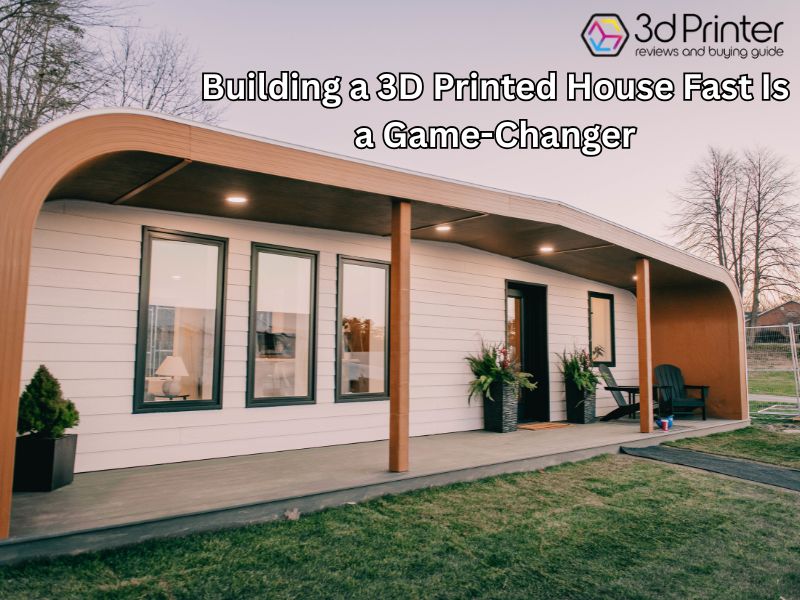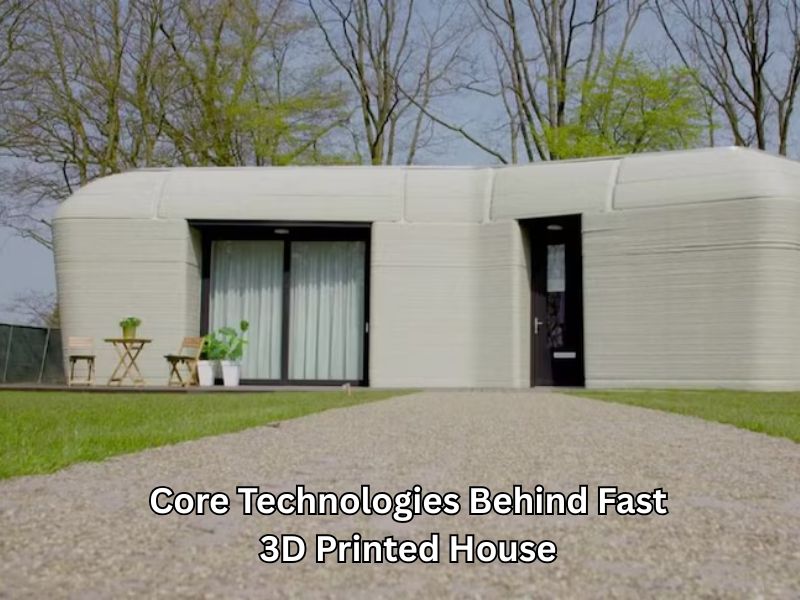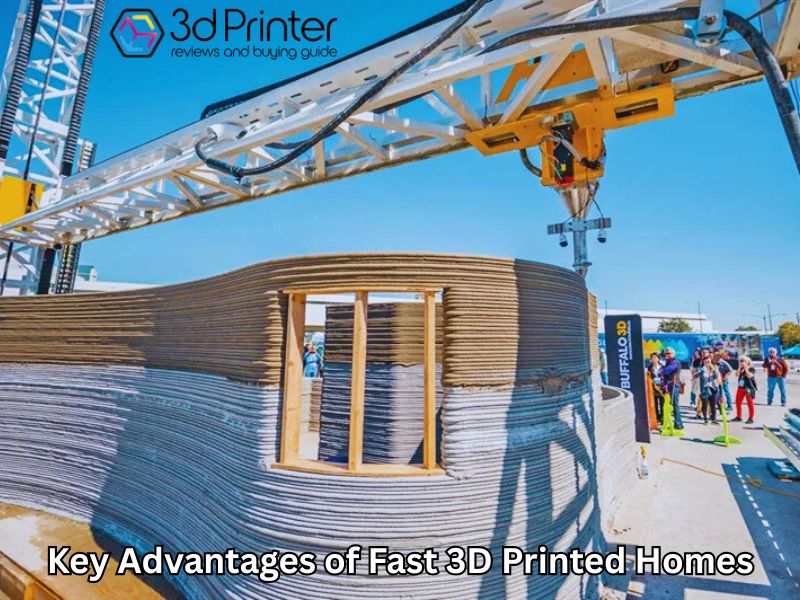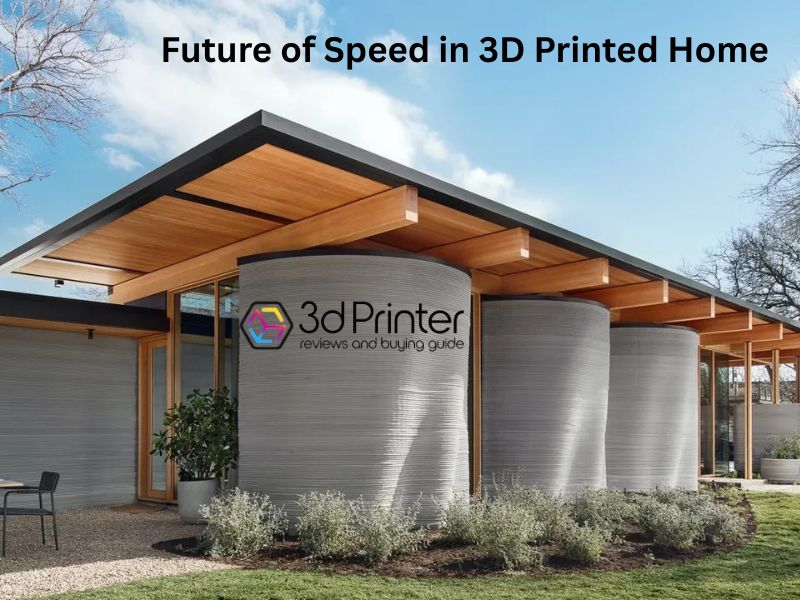I’ve spent years working on 3D-printed housing projects across the U.S., and I can say you really can build a 3d printed house fast. Concrete walls now print in just 24 to 28 hours, cutting labor and material costs dramatically. For instance, ICON’s Texas project used a powerful 3D printer to print walls in a single day and finished the home in under two weeks.
Habitat for Humanity’s Virginia build showed similar speed and savings. This technology makes fast, affordable homebuilding a reality, helping solve housing shortages with efficient, cost-effective methods.
A full wall structure can be ready in under two days. And whole neighborhoods? They go up in just a few weeks. This game-changing tech speeds up home building like never before—efficient, accurate, durable, and surprisingly eco-friendly. For those looking to start their projects, choosing the best 3d printer for small business is key to unlocking fast, high-quality construction results.

Why Building a 3D Printed House Fast Is a Game-Changer for the Housing Industry
How 3D Concrete Printing Technology Cuts Construction Time Fast
3D concrete printing builds walls by layering concrete precisely where it’s needed. This automation removes slow manual work and messy formwork. As a result, a 3D printed house that once took months to build can now be completed in just days. Fewer workers are needed on site, which helps keep the process smooth and quick.
Building a Home in Under 24 Hours vs Traditional Months
Some 3D printed houses have their main structures finished in less than 24 hours. This speed is a huge leap compared to traditional construction, which often takes many months. Faster builds mean less waiting and lower costs for builders and homeowners.
How Fast 3D-Printed Homes Save Up to 30% on Labor and Materials
Because machines handle most of the wall building, labor costs drop significantly. Material waste also shrinks, as printers only use what’s needed. These savings can reduce overall construction costs by around 30%, making a 3d printed house a more affordable housing solution.
Lower Carbon Footprint and Less Waste from 3D Printed Houses
3D printing creates less waste since there’s no excess concrete or formwork scraps. This means fewer trips to the landfill and less pollution. Plus, the precision leads to stronger, more energy-efficient homes that reduce carbon emissions over time.
Real-Life Success Stories of Fast 3D Printed Homes in the USA
3D Printed Homes Built in Just 27 Hours Using Advanced Robotic Arms
In Georgetown, Texas, advanced robotic arms printed the walls of a 3d printed house in only 27 hours. This speed shows how 3D printing can dramatically cut construction time while maintaining quality. It’s a breakthrough for fast, affordable homebuilding.
Case: Affordable Single-Family Homes Completed in Under Two Weeks
Nearby in Austin, the same technology helped build affordable single-family homes in the Mueller neighborhood in less than two weeks. These homes offer a fast, cost-effective way to meet growing housing demands.
28-Hour Home Printing Projects Supporting Affordable Housing Programs
In Virginia, 3D printed house walls were built in just 28 hours for Habitat for Humanity. This project proves how quickly 3D printing supports affordable housing efforts, speeding up construction without sacrificing strength.
Entire 3D Printed Neighborhoods with Homes Built in Just 4 to 6 Weeks
In Georgetown’s Wolf Ranch community, builders are creating an entire neighborhood of 3D printed house models. Each house takes about 3 weeks to print, making it much faster than traditional methods. These homes cost less to build and reduce waste, helping solve housing shortages efficiently.

Core Technologies Behind Fast 3D Printed House Construction
Gantry Systems and Robotic Arms
Pros:
- High precision and consistent quality
- Gantry systems allow fast printing of large flat surfaces.
- Robotic arms offer flexibility for complex shapes and custom designs.
- Automates repetitive tasks, reducing labor costs
Cons:
- Gantry systems are bulky and less mobile
- Robotic arms can be slower for large-scale wall printing.
- Both require technical expertise to operate and maintain
Mobile Printing Solutions
Pros:
- Easy to transport to remote or difficult sites
- Can operate off-grid with its own power and materials
- Rapid setup and start times speed up construction.
- Ideal for disaster relief and rural housing projects
Cons:
- Limited by printer size for very large buildings
- May need additional support equipment on site
- Higher initial investment for mobile units
Fast-Setting Concrete and Advanced Geopolymers
Pros:
- Speeds up build time by reducing curing wait
- Improves the durability and insulation of the home
- More eco-friendly with a lower carbon footprint
- Enables strong, fire-resistant walls
Cons:
- Specialized mixes can be more expensive than standard concrete.
- Requires precise formulation for best print quality
- Limited availability in some regions
Realistic Timelines: How Long Does It Take to Build a 3D Printed House?
Standard Build Durations: 1–2 Days for Walls, Weeks for Finishes
Building the walls of a 3d printed house can be incredibly fast, often completed within one to two days. This speed is a significant advantage over traditional construction, which can take weeks or months just for framing. However, the total build time for a 3d printed house includes more than printing walls. Finishing tasks like installing plumbing, wiring, roofing, and interior work usually add several more weeks before the house is move-in ready.
What Influences Build Speed: Size, Shape, Weather, and Local Regulations
Several factors affect how quickly a 3D-printed home can be completed. Larger homes naturally take longer, as do complex designs with lots of curves or details. Weather can slow down the printing process, especially if rain or cold temperatures interfere. Proper maintenance, like knowing how to level a 3D printer bed, also plays a role in ensuring smooth, fast printing. Finally, local building codes and permits may add extra time due to inspections and approvals. Overall, while the printing phase is rapid, these factors shape the full timeline.

Key Advantages of Fast 3D Printed Homes Over Traditional Construction
How Rapid 3D Home Printing Allows Scalable Building Solutions
Fast 3D printing lets builders scale up quickly. Instead of taking months, walls can be printed in just a day. This speed means entire neighborhoods can rise much faster. It’s perfect for areas needing many homes fast, like growing cities or disaster zones. The technology adapts well to different sizes and designs, making it easier to build more homes, faster.
Fewer Workers Needed and Lower Risk of Human Error
Since 3D printing is mostly automated, it needs fewer workers on site. This cuts labor costs and reduces mistakes caused by human error. The printer follows exact digital plans, making every layer precise and consistent. This helps keep quality high and speeds up the whole process without slowing down for errors.
Quicker Delivery of Homes for Emergency Shelters and Low-Income Housing
3D printing can deliver homes much faster than traditional methods. In emergencies or affordable housing projects, this speed is a game-changer. Homes can be printed in days instead of months, providing quick shelter to people in need. This helps communities respond faster and saves money on long construction times.
Minimal Disruption to Neighborhoods and Cleaner Construction Sites
3D printing creates less noise, dust, and waste compared to traditional construction methods. Since the process is more controlled and automated, there’s less heavy machinery and fewer workers moving around. This means less disruption for neighbors and a cleaner, safer building site overall.
A Beginner-Friendly Guide for DIYers or Small Builders in the USA
Choosing the Right 3D Printer or Using On-Demand 3D Home Printing Services
Picking the right 3D printer is key. For beginners, smaller models work well for prototyping and small parts. But for full home prints, using on-demand services from companies specializing in large-scale 3D home printing is often easier and faster. These services handle the heavy work and ensure quality, saving time and hassle.
Designing Efficient Home Layouts to Speed Up the 3D Printing Process
Keep your home design simple. Straight walls and basic shapes print faster and use less material. Plan by including spaces for plumbing and wiring in the design. This reduces delays during installation and helps finish the home quickly.
What to Know About Permits, Site Preparation, and Building Codes Before Printing
Before printing, check your local building rules. 3D-printed homes are new so that regulations may vary. Getting proper permits and preparing your site—like leveling the ground—is essential. Talk to local officials or experts to avoid surprises.
Combining 3D Printing with Traditional Roofing, Plumbing, and Electrical Work
3D printing builds strong walls fast, but you still need traditional methods for roofs, plumbing, and wiring. Plan how these fit together early. Hiring professionals for these parts ensures safety and code compliance.
Using Modular Print Components with Built-in Electrical and Plumbing Channels
A smart way to speed up 3D printed homes is by printing modular sections that include built-in channels for electricity and plumbing. This means the pipes and wires fit right into the walls as they’re printed. It cuts down extra work after printing and lowers mistakes from manual installation. Builders can plan utility layouts early, making the whole process faster and smoother. This method also reduces waste and saves energy, helping create eco-friendly homes.
Using Region-Based Sustainable Materials Like Clay Blends to Speed Drying and Cut Costs
Another game-changing idea is using local natural materials, such as clay blends, for 3D printing houses. These materials dry faster and cost less because they don’t have to travel far. Plus, they fit the local climate better, which helps with insulation and energy savings. Using locally sourced clay or earth also supports communities and lowers the environmental impact of building. This approach makes fast 3D printed homes both affordable and green.
Major Challenges Faced During Fast 3D Printed House Construction
| Major Challenges When Building a 3D Printed House Fast | What You Need to Know |
| Building Code and Financing Issues | Building codes often lag behind 3D printing tech. This makes getting permits tricky. Also, lenders may hesitate because 3D homes lack traditional appraisal standards. Builders usually need special approvals or alternative financing. |
| Design Limits with 3D Printing | 3D printing works best with straight walls and simple shapes. Complex curves or overhangs are hard to print and may require extra support. This limits design freedom compared to regular homes. Material choices like concrete can also affect insulation and style. |
| Extra Costs Beyond Printing | Printing cuts wall costs, but finishing touches add up. Roofing, plumbing, wiring, insulation, and HVAC aren’t printed and cost extra. These add-ons can raise the total price significantly. So, plan your budget beyond just the print. |

Looking Ahead: The Future of Speed in 3D Printed Home Construction
3D printing technology is changing how we build homes, making it faster, more innovative, and more efficient than ever before.
Next-Generation Printers with Full House Enclosure Capability
New printers can now build entire house shells, including walls, roofs, and foundations, in one continuous job. This cuts down on setup time and speeds up the process, letting builders complete homes quicker than traditional methods.
Printing Multi-Level Homes and Commercial Mixed-Use Buildings
3D printing is moving beyond simple, one-story homes. Companies are successfully printing multi-story buildings and commercial spaces, showing this tech can handle complex, larger projects with ease.
Artificial Intelligence and Machine Learning Improving Print Speed and Accuracy
AI helps 3D printers work faster and more precisely. It watches the print as it happens, catches mistakes early, and adjusts automatically. This means fewer errors, less waste, and smoother builds.
Use of Fast 3D Printing in Disaster Recovery, Rural Builds, and Off-Grid Housing
Fast 3D printing is a game-changer for disaster zones and remote areas. It allows quick, affordable home construction using local materials. This technology helps deliver shelter where it’s needed most, cutting costs and saving lives.
FAQs: Building a 3D Printed House Fast – Game-Changing Tech
Q1: How quickly can a 3D printed house be built?
Small homes can have walls printed within a day. Complete construction usually takes a few weeks, much faster than traditional builds.
Q2: What materials are used for fast 3D printed houses?
Special quick-setting concrete mixes are standard. These materials make the house strong and durable.
Q3: Are 3D printed houses more affordable?
Yes. They reduce labor and waste, cutting costs by up to 30%, making homes cheaper and more accessible.
Q4: Can 3D printing build multi-story or commercial buildings?
Absolutely. Advanced printers can create multi-level homes and commercial spaces today.
Q5: How does 3D printing help in emergencies and rural areas?
It builds durable homes quickly using local materials, speeding up shelter delivery in disasters and remote locations.
Q6: What role does AI play in 3D house printing?
AI improves printing speed and accuracy by monitoring the process and fixing errors instantly.
Q7: Are there design limits with fast 3D printing?
Complex shapes are harder, but simple, straight walls speed up printing and keep costs low.
Q8: Is 3D printed housing eco-friendly?
Yes. It creates less waste and often uses sustainable materials.
Q9: Do I need special permits for 3D printed homes?
Building codes vary by location, but many areas are updating rules to allow 3D printed houses.
Q10: Can DIY builders use 3D printing for homes?
Yes. Small printers and printing services make it possible for DIY projects and small builders.
Closing Thought
Building a 3D printed house fast is changing the way we create homes. This technology saves time and money, making it easier to build affordable and eco-friendly houses. It also helps communities recover quickly after disasters and brings housing to hard-to-reach places.
With ongoing improvements, 3D printing will soon handle bigger and more complex buildings. Fast 3D printing isn’t just a new method—it’s a breakthrough that will make homebuilding faster, greener, and more accessible for everyone. The future of quick, efficient housing is here, ready to reshape the construction world.
